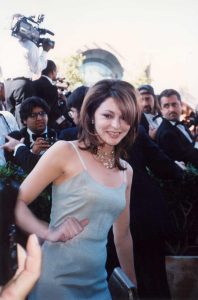Women’s fashion
Early 1990s (1990–1992)
Neon colors
In the US, USSR,[18] South Africa,[19] Egypt, and Japan popular trends included bold geometric-print clothing in electric blue, orange, fluorescent pink, purple, turquoise[20] and the acid green exercise wear[21] popularized by Lisa Lopes[22] of TLC. Typical patterns included triangles, zigzag lightning bolts, diamonds, lozenges, rectangles, overlapping free-form shapes, simulated explosions inspired by comic book illustrations or pop art, intricate grids,[23] and clusters of thin parallel lines in contrasting colors for example, white, black and yellow on a cyan background.
Leggings and exercise-wear
From 1991 on, sports bras, hoodies, shortalls, leotards and bodysuits worn as tops with jeans, a sweatshirt over a turtleneck with jeans rolled up to show off their slouch socks were popular with young girls, teens, college girls, and young women in the UK and Europe. A common outfit was to wear a skirt, dress shorts, babydoll or minidress with black opaque tights.
Grunge
In mid-1992, grunge fashion broke into the mainstream for both sexes. For younger American, Australian and Latina women, it consisted of flannel shirts, ripped jeans, hip hugger bell bottoms, wide leg jeans, shortalls, Doc Martens, combat boots, band t-shirts, small fitted sweaters, cap sleeved shirts, long and droopy skirts, ripped tights, Birkenstocks, hiking boots,[26][27][28] and eco-friendly clothing made from recycled textiles or fair trade organic cotton.[29] A prominent example of the popularity of grunge fashion is the teen drama television series “My So Called Life“.[30] Grunge fashion peaked in late 1993 and early 1994.[26][31][32]
Mid 1990s (1993–1996)
Glamour wear

In 1994, grunge clothing rapidly declined as fashion became more feminine and form-fitting. Young women in the UK and America wore tailored skirt and trouser suits, short skirts and dresses, baby doll dresses, skater dresses, animal prints, hot pants,[33] slim pants, low waisted bell bottoms, wide leg jeans and pants, long and short skirts, and high heels.[34] High-shine fabrics, such as satin, metallics, sequins, microfiber, vinyl, and silk became very prominent on both clubwear and work wear.[26][31][32] The most common look among young women that year was the short black slip dress worn over a tight, undersized white T-shirt.[31] Loungewear generally consisted of black Lycra leggings or bike shorts,[35] large T-shirts, oversized sweatshirts, turtlenecks, and baggy sweaters, slouch socks, Keds, white Sperry sneakers or athletic sneakers and hair in bangs and a ponytail with a scrunchie while at home running errands, at kids sporting events or other clubs and activities or relaxing during the weekends.
Work wear
For much of the early and mid 1990s, power dressing was the norm for women in the workplace:[44] navy blue, grey or pastel colored skirt suits with shoulder pads,[45] pussy bow blouses, silk scarves, pointed shoes, stretchy miniskirts,[46] polka dot blouses, and brightly colored short dresses worn with a dark brocade blazer, bare legs and metallic open toed shoes. Other 1980s fashions such as chunky jewelry, gold hoop earrings with horn of life pendants, smoky eye make-up, hairspray, Alice bands,[47] and brightly painted nails remained common. Shorts suits were also very popular. They consisted of a regular suit top and jacket and dress shorts with tights underneath worn with ballet flats. Also stirrup leggings worn over tights or pantyhose with flats and an oversized top.
Late 1990s (1997–1999)
Asian influences
Beginning in 1997 and continuing into the mid-2000s,[51] Southeast Asian and Indian fashion began to influence and gain greater recognition from the global media[52] due to the establishment of the Fashion Design Council of India, and the hosting of India Fashion Week in Delhi.[53] Inspired by Bollywood cinema and a resurgence of interest in 1970s fashion, designers in India adapted and repurposed the saree, churidar and kurta into the Anarkali ballgown from the early 1990s onwards.
1970s revival
From 1997 onwards, many British and American designers started to take cues from the disco fashion of the mid–late 1970s. Particularly common were black or dark red pleather pants,[57] animal print clothing, halter tops,[58] metallic clothing,[59] crop tops, tube tops, maxi coats, maxi skirts, knee boots sometimes with knee socks slouch at the top, and boot-cut dress pants.[35] By 2001, popular mainstream trends included tight shirts, bell bottoms, platform shoes,[26][60] fleeces, cropped tank tops, Union jack motifs inspired by the Cool Britannia movement,[61] and military inspired clothing, such as flak jackets with camouflage patterns.[62][63]
Casual chic
From 1998 to 2001, the unisex casual chic look gained mainstream appeal, with dark stonewash jeans, shortalls, spaghetti strap crop tops, tracksuits, sweatpants, and other athletic clothing. Denim’s popularity was at an all-time high in Europe, with designer denim jackets and matching jeans rocketing in prices. Other common, more affordable brands included Mudd, JNCO, and Evisu, a Japanese denim brand which launched in the 1980s.[67] The most popular trainers were white or black and manufactured by Adidas, Skechers, and Nike. Running shoes with built in air pumps were popular among both sexes. Leather had largely replaced canvas, and soles were made of foam rather than solid rubber.